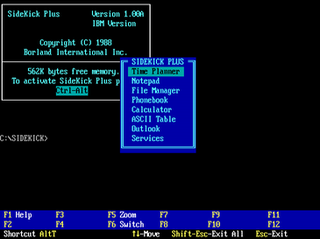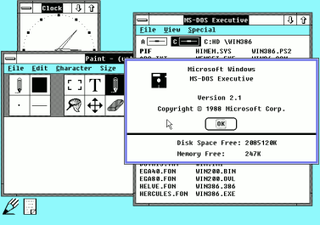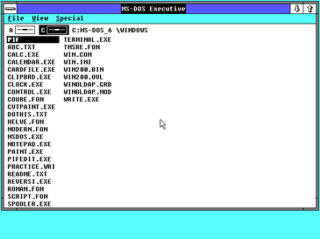Related Research Articles

Apple Attachment Unit Interface (AAUI) is a mechanical re-design by Apple of the standard Attachment Unit Interface (AUI) used to connect computer equipment to Ethernet. The AUI was popular in the era before the dominance of 10BASE-T networking that started in the early 1990s; the AAUI was an attempt to make the connector much smaller and more user friendly, though the proprietary nature of the interface was also criticized.

Lisa is a desktop computer developed by Apple, released on January 19, 1983. It is generally considered the first mass-market personal computer operable through a graphical user interface (GUI). In 1983, a machine like the Lisa was still so expensive that it was primarily marketed to individual and small and medium-sized businesses as a groundbreaking new alternative to much bigger and more expensive mainframes or minicomputers such as from IBM, that either require additional, expensive consultancy from the supplier, hiring specially trained personnel, or at least, a much steeper learning curve to maintain and operate. Earlier GUI-controlled personal computers were not mass-marketed; for example, the Xerox Alto was manufactured only for Xerox and select partners through Xerox PARC from the early to mid-1970s.

Microsoft PowerPoint is a presentation program, created by Robert Gaskins and Dennis Austin at a software company named Forethought, Inc. It was released on April 20, 1987, initially for Macintosh computers only. Microsoft acquired PowerPoint for about $14 million three months after it appeared. This was Microsoft's first significant acquisition, and Microsoft set up a new business unit for PowerPoint in Silicon Valley where Forethought had been located.

CompuServe was an American online service, the first major commercial one in the world. It opened in 1969 as a timesharing and remote access service marketed to corporations. After a successful 1979 venture selling otherwise under-utilized after-hours time to Radio Shack customers, the system was opened to the public, roughly the same time as The Source. H&R Block bought the company in 1980 and began to more aggressively advertise the service.

Adobe PageMaker is a desktop publishing computer program introduced in 1985 by the Aldus Corporation on the Apple Macintosh. The combination of the Macintosh's graphical user interface, PageMaker publishing software, and the Apple LaserWriter laser printer marked the beginning of the desktop publishing revolution. Ported to PCs running Windows 1.0 in 1987, PageMaker helped to popularize both the Macintosh platform and the Windows environment.

A/UX is a Unix-based operating system from Apple Computer for Macintosh computers, integrated with System 7's graphical interface and application compatibility. It is Apple's first official Unix-based operating system, launched in 1988 and discontinued in 1995 with version 3.1.1. A/UX requires select 68k-based Macintosh models with an FPU and a paged memory management unit (PMMU), including the Macintosh II, SE/30, Quadra, and Centris series.

AppleWorks was an integrated office suite containing a word processor, database, and spreadsheet. It was developed by Rupert Lissner for Apple Computer, originally for the Apple II platform and launched in 1984. Many enhancements for AppleWorks were created, the most popular being the TimeOut series from Beagle Bros which extended the life of the Apple II version of AppleWorks. Appleworks was later reworked for the Macintosh platform.

Borland Sidekick was a personal information manager (PIM) launched by American software company Borland in 1984 under Philippe Kahn's leadership. It was an early and popular terminate-and-stay-resident program (TSR) for MS-DOS which enabled computer users to activate the program using a hot key combination while working in other programs. Although a text-mode program, Sidekick's window-based interface echoed that of the Apple Macintosh and anticipated the eventual look of Microsoft Windows 2.0. It included a personal calendar, text editor, calculator, ASCII chart, address book, and phone dialer. According to the prospectus for Borland's initial public offering of stock to the public, Sidekick sold more than 1 million copies in its first three years.

eWorld was an online service operated by Apple Inc. between June 1994 and March 1996. The services included email, news, software installs and a bulletin board system. Users of eWorld were often referred to as "ePeople."

Mouse Systems Corporation (MSC), formerly Rodent Associates, was founded in 1982 by Steve Kirsch. The company was responsible for bringing the mouse to the IBM PC for the first time.
NavCIS was CompuServe Information Service's client program for automated connections to the CompuServe Information Service, at a time when online use was priced per minute. It was largely an offline reader, downloading both email and new messages from selected forums, and then disconnecting. The user could then read and reply to these messages offline, and send all of their replies back in a similarly quick connection. Unlike most offline readers, NavCIS also allowed the user to select files for upload and download, and included a system for scripting the session.

Irma board, originally spelled IRMA board, refers to a brand of coaxial interface cards for PCs and Macintosh computers used to enable 3270 emulator programs to connect to IBM mainframe computers. IRMA boards were used to connect PCs and Macs to IBM 3274 terminal controllers.
Meeting Maker is a cross-platform personal calendar and group scheduling software application from PeopleCube. First released in 1991 for Macintosh by ON Technology, support for other platforms followed in 1993 with Meeting Maker XP. Alongside Windows and Mac, native clients were released for OS/2 and Solaris, and later also for other platforms. Some support was also introduced for mobile platforms like Apple Newton, PalmPilot and Windows CE. Although powerful, its user interface - aiming at uniformity across multiple platforms — was criticized as weak and not supporting all features of target platforms.

Windows 2.1 is a major release of Microsoft Windows. It was released to manufacturing on May 27, 1988, as a successor to Windows 2.0.

Windows 3.1 is a major release of Microsoft Windows. It was released to manufacturing on April 6, 1992, as a successor to Windows 3.0.

Windows 2.0 is a major release of Microsoft Windows, a family of graphical operating systems for personal computers developed by Microsoft. It was released to manufacturing on December 9, 1987, as a successor to Windows 1.0.

Altos Computer Systems was founded in 1977 by David G. Jackson and Roger William Vass Sr. It focused on small multi-user computers, starting with multi-user derivatives of CP/M, and later including Unix and Xenix-based machines. In its 1982 initial public offering on NASDAQ, the company raised $59M. Thereafter the company's stock was traded under the symbol ALTO.
DUsers is an Apple Macintosh users' group at Drexel University in Philadelphia. It was founded in the Fall of 1983 by Drexel students interested in learning more about the Macintosh, even before it was released to the public. Drexel University had made the decision to require that all incoming freshmen of Fall 1983 were required to buy a computer, and had selected Apple as the provider.

Chuck Colby was an electronics engineer and chief-inventor, founder and president of Colby Systems Corporation, a company that created the first DVR-based video surveillance systems but is also very notable as a pioneer in portable computing, being the first to market both DOS and Macintosh portable computers, as well as a remarkable number of other technological firsts.

Dr. Halo is a raster graphics editor developed by Media Cybernetics and released for computers running MS-DOS. It was among the first graphics editors available for MS-DOS with its initial release in 1984. Media Cybernetics boasted about three million users of Dr. Halo between 1984 and 1993.
References
- ↑ InfoWorld Media Group, Inc. (14 August 1989). "InfoWorld". InfoWorld: The Newspaper for the Microcomputing Community. InfoWorld Media Group, Inc.: 14–. ISSN 0199-6649 . Retrieved 24 August 2013.
- ↑ PC World. PC World Communications. 1990. Retrieved 24 August 2013.
- ↑ InfoWorld Media Group, Inc. (5 March 1990). "InfoWorld". InfoWorld: The Newspaper for the Microcomputing Community. InfoWorld Media Group, Inc.: 14–. ISSN 0199-6649 . Retrieved 2 August 2019.